
endangered
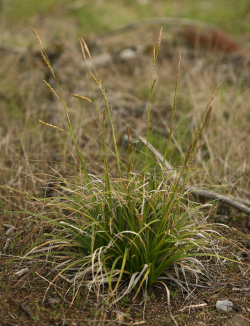
San Luis Obispo sedge (Carex obispoensis), a cespitose perennial herb. Cuesta Ridge Botanical Area, San Luis Obispo County, CA, 2 April 2006. Copyright © 2006 Steve Matson.
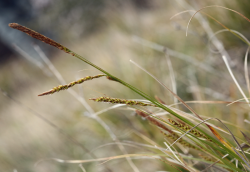
San Luis Obispo sedge (Carex obispoensis), inflorescence with staminate spikelet distally and lateral, androgynous spikelets. Cuesta Ridge Botanical Area, San Luis Obispo County, CA, 2 April 2006. Copyright © 2006 Steve Matson.
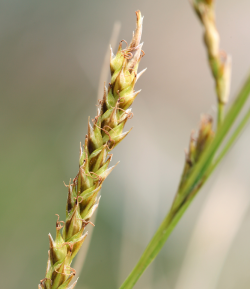
San Luis Obispo sedge (Carex obispoensis), close-up of lateral, androgynous spikelet. Cuesta Ridge Botanical Area, San Luis Obispo County, CA, 2 April 2006. Copyright © 2006 Steve Matson.
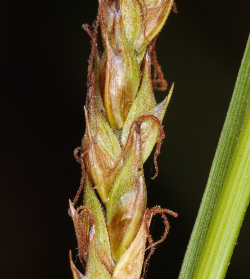
San Luis Obispo sedge (Carex obispoensis), brown pistillate flower bracts with white margins. Cuesta Ridge Botanical Area, San Luis Obispo County, CA, 2 April 2006. Copyright © 2006 Steve Matson.
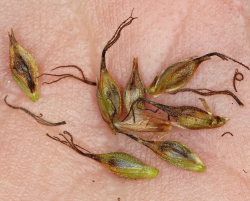
San Luis Obispo sedge (Carex obispoensis), evenly short-pubescent perigynia, with 3 stigmas still visible on some. Cuesta Ridge Botanical Area, San Luis Obispo County, CA, 2 April 2006. Copyright © 2006 Steve Matson.



This fact sheet was prepared by Dylan M. Neubauer under award NA04N0S4200074 from the National Oceanic and Atmospheric Administration (NOAA), U.S. Department of Commerce (DOC). The statements, findings, conclusions, and recommendations are those of the authors and do not necessarily reflect the views of the NOAA or the DOC.
© Copyright 2006, Elkhorn Slough Coastal Training Program
Last updated: Nov 27, 2017 14:08
Common Names - San Luis Obispo sedge
Family - Cyperaceae (Sedge Family)
State Status - none
Federal Status - none
Habitat
Generally near seeps, springs, or other mesic areas in habitats including coastal prairie/grassland, maritime and montane chaparral, coastal scrub, Sargent cypress woodland, and redwood/mixed-evergreen forest; generally on serpentinite substrates, sometimes on sandstone, gabbro, or granitic substrates; < 800 m.
Key Characteristics
Cespitose perennial herb; stems 6–20 dm tall, glabrous; leaf blades 2.5–10 mm wide, V-folded; proximal inflorescence bract leaf-like, < inflorescence, sheath > 9 mm long; 1–2 distal lateral spikelets nodding, occasionally androgynous, proximal spikelet long-pedunculate; distal spikelets staminate, occasionally androgynous, erect, crowded near apex, sessile or short-pedunculate; pistillate flower bract brown, margin wide, whitish, < mature perigynia; stigmas 3; perigynia 5–8 mm long, 12–20-veined, green, generally with red dots, lanceolate, evenly short-pubescent, gradually tapered to stout beak ± 2 mm long, teeth erect, margins serrulate (Ball and Reznicek 2002, Zika et al. 2015).
Carex obispoensis has been placed within section Hymenochlaenae (Waterway 2002), along with C. cyrtostachya, C. gynodynama, C. hirtissima, and C. mendocinensis. Like C. obispoensis, C. mendocinensis grows in “moist areas, often serpentine” (Zika et al. 2015), though it has a much wider range (central California to southern Oregon).
A single San Luis Obispo County C. mendocinensis collection exists—(Hardham 6160) from a Sargent cypress grove at the headwaters of Chris Flood Creek (San Carpoforo), where the plant was growing in serpentine (CCH 2017). The nearest collection of C. obispoensis is from a Sargent cypress grove is to the southeast on Burnett Peak (Hardham 6000) (CCH 2017). Carex mendocinensis has been collected in the Santa Lucia Range in Monterey County within the range of C. obispoensis (Alder Creek, Los Burros Creek, Waterdog Creek, growing with Sargent cypress), though the two sedges do not appear to grow sympatrically. Interestingly, C. obispoensis is not known to occur with Sargent (or any other) cypress in Monterey County.
Carex mendocinensis can be difficult to distinguish from C. obispoensis, but has its proximal inflorescence bract ≥ inflorescence, and its perigynia shorter (< 4 mm long) and generally glabrous (rarely sparse-appressed-hairy near beak) (Zika et al. 2015).
Flowering Period
March to June
Global Distribution
This California endemic occurs in the outer South Coast Ranges (SCoRO; Santa Lucia Range, Irish Hills) and along the coast (CCo), in Monterey and San Luis Obispo counties, and in the Peninsular Ranges (PR) in San Diego County.
Reference Population
Willow Creek–Los Burros Road, Santa Lucia Range, Los Padres National Forest (Monterey County).
Discussion
The type specimen was collected by Alice Eastwood and John Thomas Howell (2271) on 7 May 1936 at Steiner Creek near San Luis Obispo on a “boggy slope on serpentine shaded by Quercus durata” (CNDDB 2017). In his 1970 flora of San Luis Obispo County, Robert F. Hoover states that C. obispoensis was not known outside of the county, but was to be expected in southern Monterey County.
Hoover (1970) observes that Carex obispoensis reaches “its greatest abundance along the ridge northwest of Cuesta Pass, where it grows luxuriantly under [Sargent] cypresses” (see also Hardham 1962). This serpentine habitat within the Los Padres National Forest was designated as a Special Interest Area (Cuesta Ridge Botanical Area) in 1969 and is home to a number of sensitive plant taxa. In some parts of the Arroyo de la Cruz region—a plant biodiversity hotspot (Haydu 2012) in the northwest part of the county—C. obispoensis is “the dominant plant,” extending from the lowest marine terraces eastward, where it grows “in association with grasslands and with dwarf chaparral” (Keil and McCloud 1989).
Carex obispoensis was first collected in Monterey County in 1987 by Vern Yadon at the UC Landels-Hill Big Creek Natural Reserve (serpentinite substrate), and the sedge was subsequently found in two other locations in the county: a northern occurrence lies inland from Bixby Bridge (granitic substrate), and a southern occurrence lies in the Willow Creek watershed (serpentinite substrate). Field work is required to determine whether more Monterey County populations exist.
In 2004, a widely disjunct range extension of Carex obispoensis was collected in San Diego County in interior chaparral growing in gabbroic and granitic substrates on Sycuan Peak (a California Department of Fish and Wildlife Ecological Reserve). Though plants keyed to C. obispoensis, they had in fewer pistillate flowers (Rebman and Gregory 10325, CCH 2017). Two additional San Diego County occurrences were located in 2005 in the vicinity of McGinty Mountain (Mulligan et al. 1316; CCH 2017) within another CDFW Ecological Reserve (CNDDB 2017).
Conservation and Threats
San Luis Obispo County supports 23 occurrences with a variety of ownerships, including nine on lands owned privately or with ownership unknown. Four of those occurrences are located on Hearst Corporation property, where grazing is the main threat. There are two occurrences on Forest Service land (Cuesta Ridge, Cerro Alto), with threats including non-native plants, improper burning regime, road maintenance, erosion, and cattle/feral pigs. A Bureau of Land Management occurrence near Rinconada Mine icontained thousands of plants in 2014. The type locality is on City of San Luis Obispo land, and the population there is quite small; its current status is unknown (CNDDB 2017).
In Monterey County, one occurrence is on private land and threats are unknown. Threats at the Landels-Hill Big Creek Natural Reserve include erosion, non-native plants, and changes in fire-frequency and hydrology. The Willow Creek occurrence is on Los Padres National Forest land and is potentially threatened by road maintenance and recreational activities (CNPS 2011, CNDDB 2017). ) In addition, small populations are vulnerable to random, stochastic events.
References
Ball, P. W. and A. A. Reznicek. 2002. Carex obispoensis, in Flora of North America Editorial Committee, (eds.) 1993+. Flora of North America North of Mexico. 19+ vols. New York and Oxford. Vol. 23. http://www.efloras.org/florataxon.aspx?flora_id=1&taxon_id=242357365 [acc. 25 November 2017].
California Native Plant Society (CNPS), Rare Plant Program. 2011. Carex obispoensis. Inventory of Rare and Endangered Plants (online edition, v8-03 0.39). California Native Plant Society, Sacramento, CA. http://www.rareplants.cnps.org/detail/390.html [acc. 25 November 2017].
California Natural Diversity Database (CNDDB). 2017. [Internet]. California Department of Fish and Wildlife [acc. 25 November 2017].
Consortium of California Herbaria (CCH). 2017. [Internet]. [acc. 25 November 2017].
Hardham, C. B. 1962. The Santa Lucia Cupressus sargentii groves and their associated northern hydrophilous and endemic species. Madroño 16(6):173–179.
Haydu, K. 2012. Mapping plant biodiversity hotspots at the county scale: a new tool for establishing resource conservation strategies. Master’s Thesis, California Polytechnic State University, San Luis Obispo, CA.
Hoover, R. F. 1970. The vascular plants of San Luis Obispo County, California. University of California Press, Berkeley, CA.
Keil, D. and M. McLeod. 1989. Rare plants in the Arroyo de la Cruz Endemic Area, San Luis Obispo County, California, in Conservation and management of rare and endangered plants: proceedings from a conference of the California Native Plant Society, Thomas S. Elias (ed.). California Native Plant Society, Sacramento, CA.
Los Padres Forest Watch. 2017. San Luis Obispo sedge: Carex obispoensis. http://lpfw.org/our-region/wildlife/san-luis-obispo-sedge/ [acc. 25 November 2017].
Matthews, M. A. and M. Mitchell. 2015. The plants of Monterey County: an illustrated field key, Second Edition. Monterey Bay Chapter, California Native Plant Society, Carmel, CA.
Reznicek, A. A. 1982. Two new species of Carex (Cyperaceae) from southern Mexico. Systematic Botany 7(3):340–344.
Stacey, J. W. 1936. Notes on Carex—VII. Leaflets of Western Botany 1(20):240–241.
Stephenson, J. R. and G. M. Calcarone. 1999. Southern California mountains and foothills assessment: habitat and species conservation issues. General Technical Report GTR-PSW-172. USDA Forest Service, Pacific Southwest Research Station, Albany, CA.
USDA Forest Service. Carex obispoensis. SoCalBiodiversity-Plants (species descriptions). https://www.fs.usda.gov/Internet/FSE_DOCUMENTS/stelprd3832682.pdf [acc. 25 November 2017].
Waterway, M. J. 2002. Carex L. sect. Hymenochlaenae, in Flora of North America Editorial Committee, (eds.) 1993+. Flora of North America North of Mexico. 19+ vols. New York and Oxford. Vol. 23. http://www.efloras.org/florataxon.aspx?flora_id=1&taxon_id=302705 [acc. 26 November 2017].
Zika, P. F., L. P. Janeway, B. L. Wilson, and L. Ahart. 2013. Carex crytostachya (Cyperaceae) a new species of sedge endemic to the Sierra Nevada of California. Journal of the Botanical Research Institute of Texas 7:25–35.
Zika, P. F., A. L. Hipp, and J. Mastrogiuseppe. 2015. Carex obispoensis, in Jepson Flora Project (eds.) Jepson eFlora, Revision 3, http://ucjeps.berkeley.edu/eflora/eflora_display.php?tid=17679 [acc. 25 November 2017].
Reviewer
Peter Zika, co-author, Carex treatment, Jepson eFlora, 2015.
